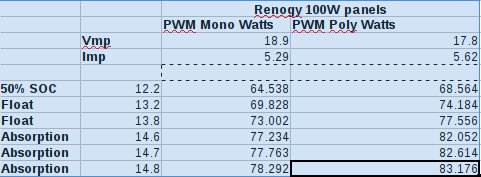PWM loves poly
[this is an old draft I’m going to publish]
I was thinking about how common 100W Renogy panels are (both mono and poly) and how to extract maximum power from them with PWM controllers.
The question is on my mind because no folks will link to one of Renogy’s mono/pwm kits and ask for feedback. I am annoyed that they offer mono/pwm at all; it’s an inefficient combo for the user.
-
The Renogy 100W polycrystalline panel is a better fit for PWM controllers than mono because poly makes more usable power at the lower voltages PWM run the panels at.
-
raising float from 13.2v to 13.8v on either panel will increase power output by 4.5% (do not exceed battery manufacturer’s Absorption specs.)
-
setting float voltage to absorption voltage per sternwake will increase power output from either panel between 6-12% and will not unduly harm regularly cycled batteries.
-
PWM equals MPPT output on poly when ambient temps >97F due to inherent DC-DC conversion losses with MPPT and cell temperature derating.
Here are the stats on the ones I’m talking about

Can you see what’s going on in the chart? For these panels with the same rating (100w), poly puts out about 6% more current (5.62A) than mono (5.29A).
It doesn’t matter with MPPT, since it makes power from the entire voltage range regardless of battery voltage (Vbatt), making ~95w in this theoretical scenario. But it is important for PWM which ties the panels to battery voltage (Vbatt). If you are limiting panel voltage to a max of 14.8v as above, you want to multiply that 14.8v by the biggest amperage number you can get.
And the poly panels tend to be about 10% cheaper. Less money and more power? Seems to be a compelling argument for going poly if you plan on running a PWM controller.